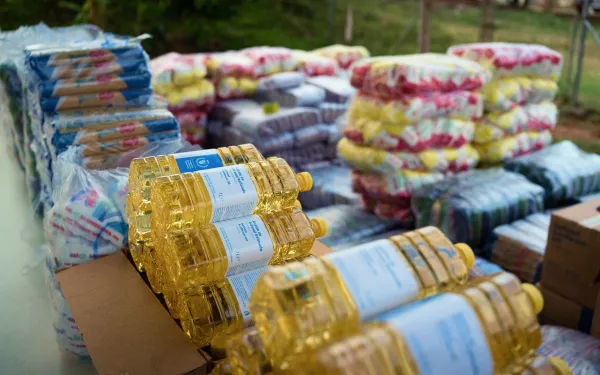

What’s inside a typical WFP food basket
Rice or flour
A staple item in many countries and vital source of daily energy.
Vegetable oil
Rich in essential fats and vitamins, supporting a healthy immune system.
Lentils or beans
Plant-based protein and fibre, helping maintain a healthy heart and gut.
Salt
Supports a healthy pregnancy and helps child development.
The food basket is based on local food preferences and diets wherever possible so the items could vary.
WFP continues to optimise its operations by using all available supply routes including an expanded Turkish corridor as well as Jordan, Lebanon and routes from Syrian ports. This ensures lower shipping costs and lower food costs, meaning more aid can reach people in need.
Overview
Shared meals will provide emergency food, nutrition support, school meals and resilience activities in Syria.
Hunger is on the rise in Syria following 13 years of conflict. An estimated 12.9 million people are facing hunger this year (2024), making Syria one of the 10 most food-insecure countries globally. A recent WFP survey showed that 1 in 3 children go to school without breakfast, while 8 out of 9 children do not meet nutrition requirements. Food prices are on the rise and the production of bread — a staple in Syria — has been under strain in recent years. Syria has seen a recent influx of people due to the violence in Lebanon, and WFP is responding by providing fortified date bars and fresh meals to people arriving at the main border crossings. WFP also plans to scale up support by distributing food rations, ready-to-eat rations, hot meals and e-vouchers at host centres and host communities. Despite major funding shortages, WFP is on the ground providing life-saving food assistance. School feeding programmes reached over 850,000 children with fresh meals, date bars and electronic cash for families in 2023. Parents can redeem the cash in local shops, putting money back into the economy. WFP is also focusing on strengthening nutrition, particularly amongst pregnant and breastfeeding women. Supplementary foods and vouchers help Syrians diversify their diets. Finally, WFP is working to drive self-sufficiency amongst Syrian communities. Improving infrastructure such as bakeries and irrigation canals creates jobs and long-term food security.
Location
Syria